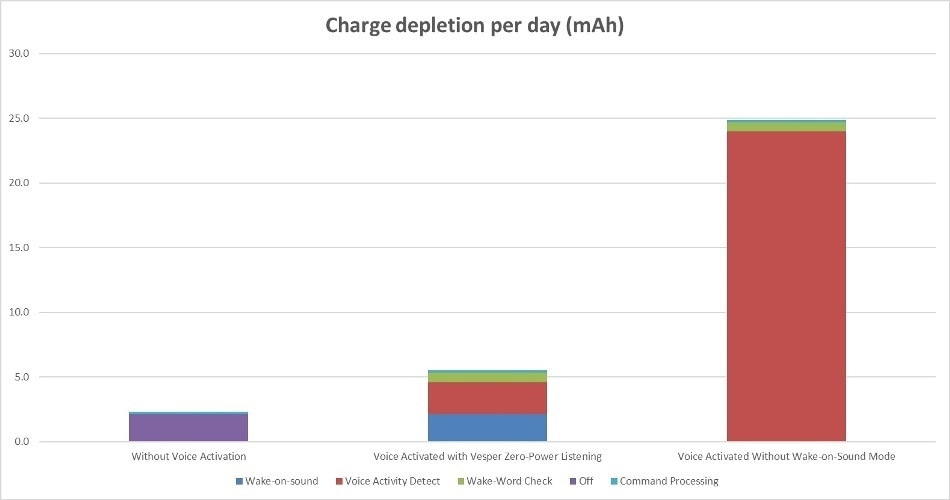ZPL™ offers a unique microphone system which is appropriate for use in portable devices, however the power usage can only be optimized if it is used alongside a complete system that can run in ultra-low power mode. For this reason, it is important to consider other developments in industry which can be used to design frictionless, voice-activated systems.
In order to operate handsfree, voice-controlled remotes must be able to cancel environmental background noise to be able to accurately hear wake commands, and this must be achieved using an ultra-low power transport method. The power usage must be minimized at several different stages in the far-field remote to provide an extended battery lifetime. This means everything from the microphone, to the voice processor and on-chip processor must all be able to run on ultra-low power.
For the voice-processor there are several ultra-low power options available for both digital and analog signal processing.
The Apollo range from Ambiq are processors designed for the computational processing of audio signals in portable devices. ARM Cortex-MF based Apollo2 and Cortex-MF4 based Apollo1 can provide processing at ultra-low powers of just 143 nA current when in deep sleep and 35 μA/MHz when processing.
The Apollo2 Blue range is a system on chip processor that can be used for multi-mic array signal processing at a full power consumption of only 10 μA/MHz. The Apollo Blue range’s integrated Bluetooth Low Energy radio provides further energy savings making it appropriate for handsfree voice-operated remotes.
Another appropriate system is DSP Group’s DBMD6 chip which uses novel HDClear™ voice technology to ignore background noises and to cancel out acoustic echoes to deliver enhanced accuracy for far-field use. The chips can interface with digital or analog signals at a low power mode which uses only 40 uW of power in standby and 3.1 mW of power when in use.
Combining these ultra-low power voice processing solutions with Vesper’s ZPL™? systems will enable the design of the next generation portable electronic devices. In addition to being used for handsfree voice-controlled remotes other applications are also possible such as hearables, wearables and security systems.
Battery Life Analysis on a Handsfree Remote Control: Analytical Model
Vesper has created an analytical model to study the extension in battery lifetime achieved using their Wake on Sound (WoS) microphone when compared to other available solutions. This section explores this analytical model.
Vesper’s analytical model monitors the time periods over which events take place, the time taken for processing and the power use of the different components for each application to compare the battery lifetime of WoS systems with conventional systems.
The analytical model assumes that the system is powered using 2 x AA batteries which each have 1.5 v and 2400 mAh capacity. Far-field processing is enabled using a VM1010 microphone alongside two auxiliary digital microphones. The model takes the power consumption of the VM1010 microphone and DSP Group DBDM6 platform, and its wake command detection system, to determine the total power usage for the different modes, i.e. WoS mode, voice activity detect mode, wake command processing and full power mode. These modes are shown in Figure 2 for an always listening system.

Figure 5: Energy depletion with Wake on Sound Vs alternate listening solutions.

Figure 6: Battery life savings with wake on sound Vs alternate listening solutions.
These calculations are made with the assumption that the VM1010 has a noise threshold of 65 dB – the lowest threshold setting for the microphone.
It has been found that the voice activity detection mode in systems which don’t use a WoS microphone can use more than 80% of the battery capacity at any given time. The addition of a WoS mode, which is active before voice activity detection, in the VM1010 microphone optimizes the time at which the system is in voice activity detection mode. These savings in time result into savings in the battery lifetime of the system (Figure 6).
WoS microphone systems have been demonstrated to increase the standby battery lifetime of the system by more than 10 times, with an overall lifetime saving of 4 times when compared to conventional systems for everyday use. The battery life savings provided by WoS systems is comparable to push to talk systems, with the added advantage of an improved user experience.
The power savings provided by WoS systems can be further optimized by adjusting the WoS noise threshold, and therefore its power consumption, on the DSP processor depending on the application the system will be used in.

 Download the Full White Paper Here
Download the Full White Paper Here

This information has been sourced, reviewed and adapted from materials provided by Vesper Technologies, Inc.
For more information on this source, please visit Vesper Technologies, Inc.